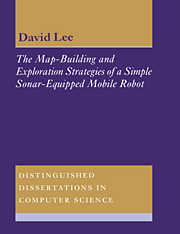 The Map-Building and Exploration Strategies of a Simple Sonar-Equipped Mobile Robot
The Map-Building and Exploration Strategies of a Simple Sonar-Equipped Mobile Robot Book contents
- Frontmatter
- Contents
- Preface
- 1 Question, Context and Method
- I Starting Points
- 2 Maps Used in Previous Research
- 3 The Maps Used in This Research
- 4 Approaches to Exploration
- II System Components
- III Experiments
- Appendix A The Feature-Map Data Structure
- Appendix B Test Rooms
- Appendix C Finding the Best-Fit Line
- Appendix D ARNE's Standard Dialogue
- Bibliography
- Index
3 - The Maps Used in This Research
Published online by Cambridge University Press: 05 March 2012
- Frontmatter
- Contents
- Preface
- 1 Question, Context and Method
- I Starting Points
- 2 Maps Used in Previous Research
- 3 The Maps Used in This Research
- 4 Approaches to Exploration
- II System Components
- III Experiments
- Appendix A The Feature-Map Data Structure
- Appendix B Test Rooms
- Appendix C Finding the Best-Fit Line
- Appendix D ARNE's Standard Dialogue
- Bibliography
- Index
Summary
Chapter 2 described numerous maps which have been used by mobile robots. This chapter considers which type of map to use in the current research.
The choice of map type is strongly constrained by the proposed application of the robot. In Chapter 1 a delivery application was chosen. Section 3.1 describes such an application in detail.
Section 3.2 uses the knowledge of the application to choose the maps to be used in this thesis. One of the most important choices was between probabilistic grid-based maps and feature-based maps. Section 3.3 explains why feature-based maps were selected. The chapter concludes in Section 3.4 by explaining why the robot will build its own map, instead of being given one by its operator.
The details of the map construction algorithm can not be described without knowledge of the robot and its sensors. This description is therefore postponed until Chapter 7 to follow the descriptions of the hardware and the sensor model in Chapters 5 and 6.
3.1 The Application
The choice of world model is strongly influenced by the proposed application of the robot. Indeed, as was discussed in Chapter 2, some applications do not require a world model at all. It is therefore vital to be precise about the intended application of one's robot before designing the world model.
This thesis addresses the construction of maps for use in an application with the following features:
- Type
- Chapter
- Information
- The Map-Building and Exploration Strategies of a Simple Sonar-Equipped Mobile RobotAn Experimental, Quantitative Evaluation, pp. 27 - 36Publisher: Cambridge University PressPrint publication year: 1996
